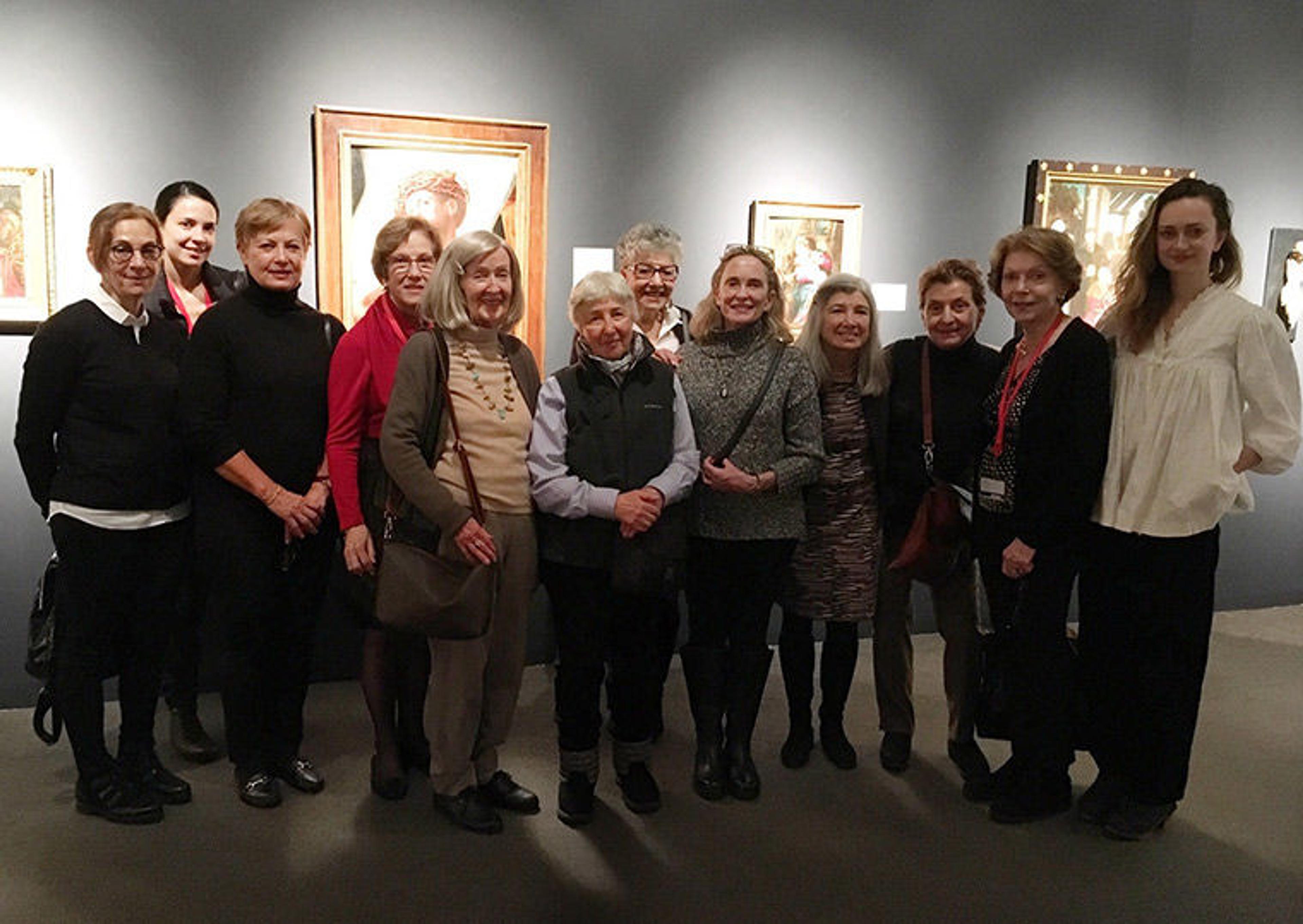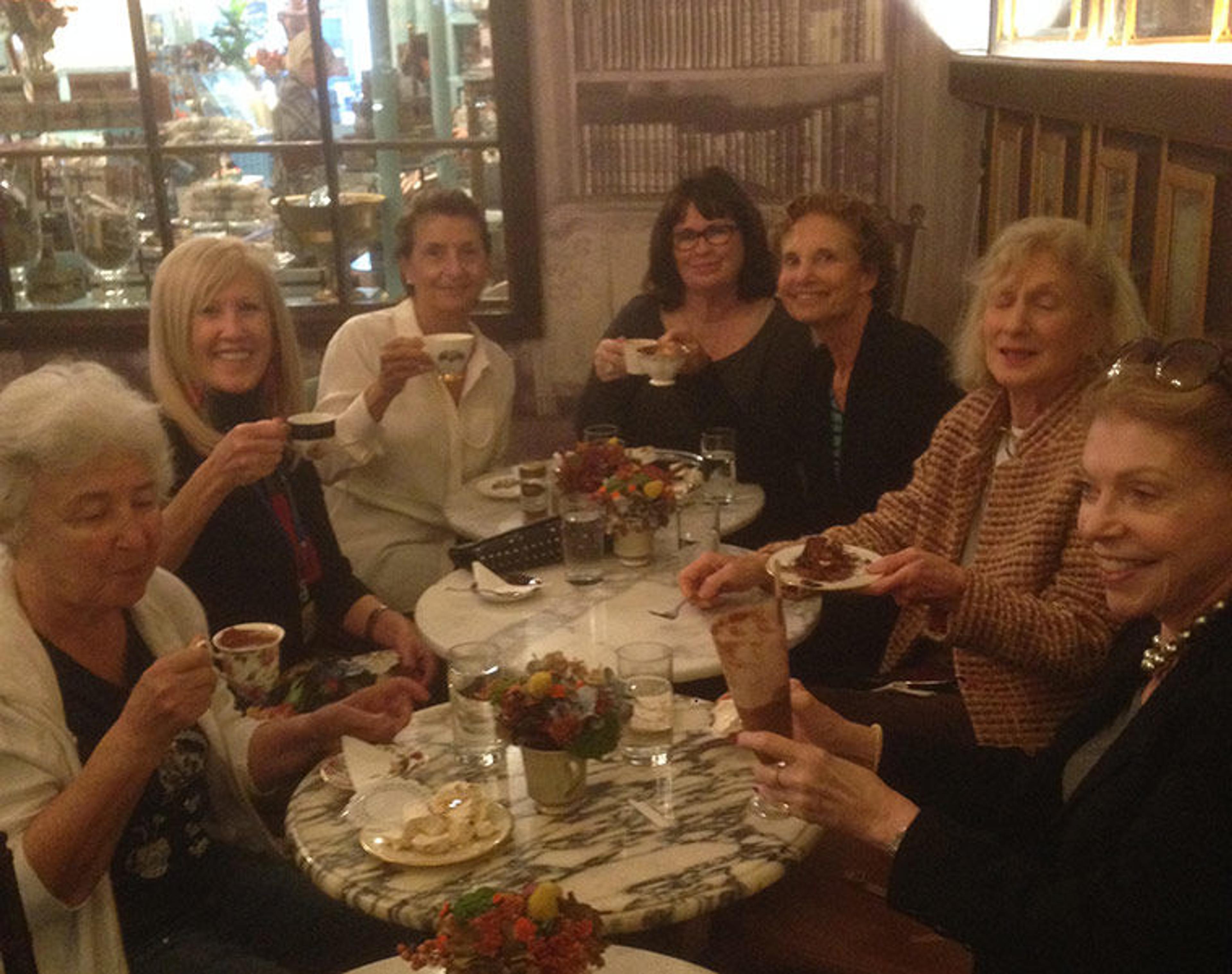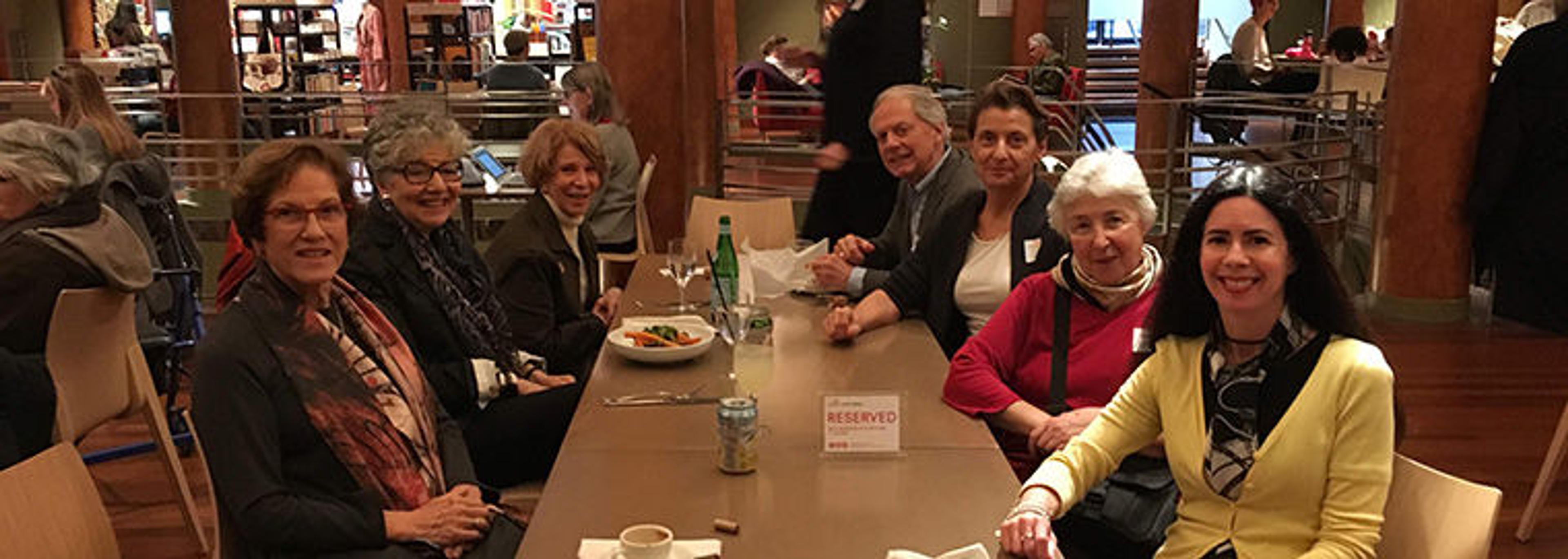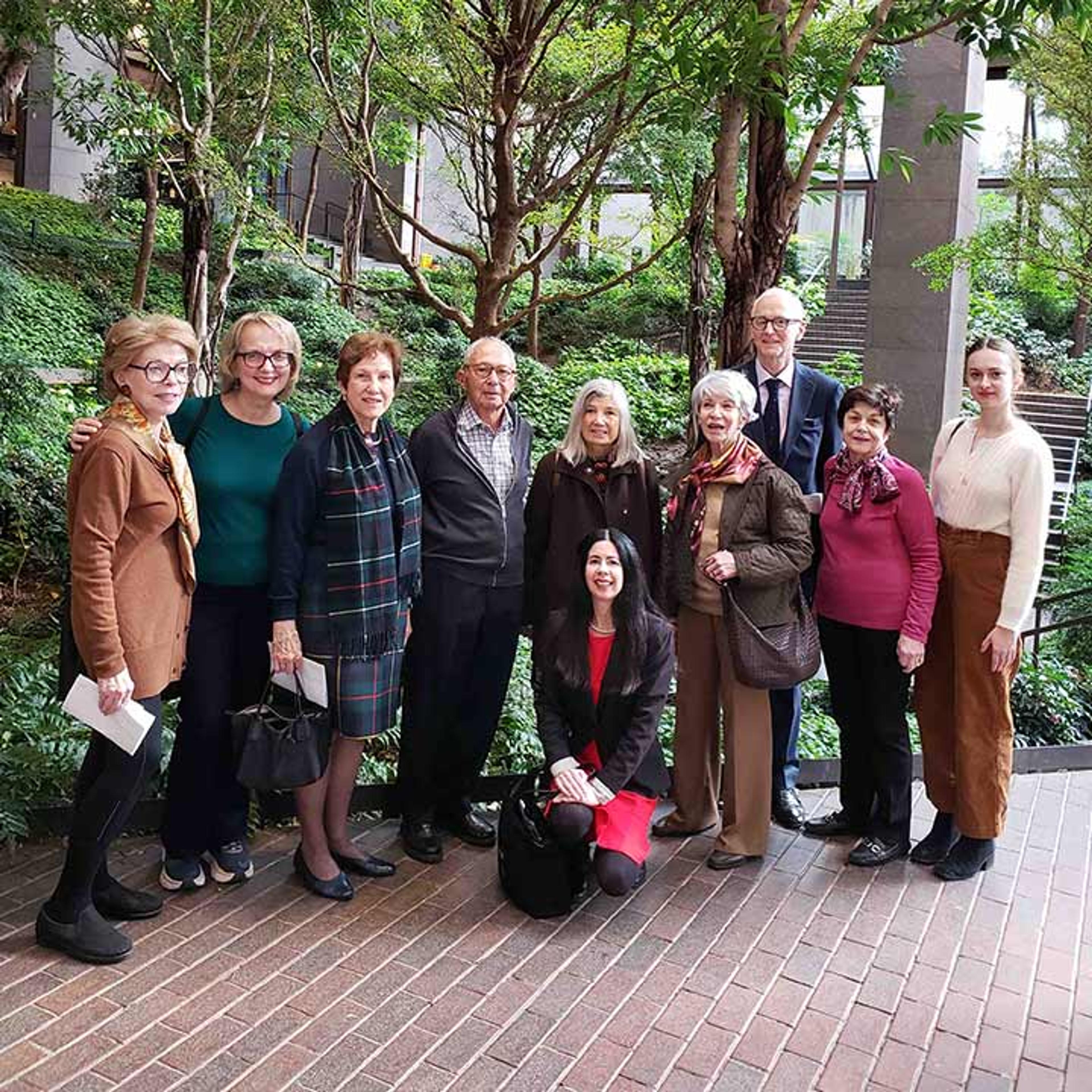
Watson Library volunteers visit The Ford Foundation, Spring 2019. Photo courtesy of Holly Phillips
Watson Library is known in and beyond The Metropolitan Museum of Art for its exceptional staff of thirty-two intelligent, collegial, and service-oriented individuals dedicated to fueling the Museum's research through librarianship. Lesser known to the outside world, but of equal importance, are the sixty library volunteers working behind the scenes performing tasks essential to library operations.
Whether in Technical Services, Acquisitions, Book Conservation, or the Nolen Library Reference Desk, the high-quality work performed by our invaluable library volunteers is universally appreciated. Because of them, Watson Library has continued to grow and thrive. On behalf of the Watson Library Staff, I thank our volunteers wholeheartedly.
Below are memories that some of Watson's volunteers shared with me.

Library Volunteers tour of Sotheby's. Photo courtesy of Holly Phillips.
Sophia Alexandrov (SIA): When did you begin volunteering in Watson and what brought you to the Library?
Susan Appel (SA): I started to volunteer sometime early in 2016. I met Ken Soehner in 2013. He came and spoke with Lotos Club Library members about the Watson Library and gave us a wonderful tour of the stacks. In May of 2014, I went on a Metropolitan Museum Tour of the Libraries and Galleries of Florence and Rome with Ken and Frank Dabell, a former Metropolitan curator. We ran ourselves ragged but didn't miss any highlights of either city. I came to realize that libraries were fascinating repositories of all human knowledge. I then asked Ken if I could become a volunteer in the library.
Tom Foster (TF): Ken interviewed me in late 2006 and I began as a volunteer in January 2007. In anticipation of our move [from D.C. to New York], we had become active out-of-town members of the Museum in the late nineties and I even was able to obtain a library card for my own research use. Although I enjoyed wandering around the galleries, I was always happiest immersed in a book.
Nina Libin (NL): About 20 years ago. I love books and have been interested in book art, specifically in book constructions and binding, and the Book Conservation Lab of the Watson Library has proved to be the right place.
Chuck Werner (CW): I became a volunteer at Watson in the Summer of 2003. That Spring, I had met Ken Soehner on a Metropolitan Museum trip to Cuba. We met for lunch shortly after our return. At that meeting I told Ken that I had been retired for a year and was looking for an interesting assignment. As a book lover and owner of an independent bookstore (The Book Cove in Pawling, NY), I thought that Watson would be a perfect fit. Ken immediately replied that he had something for me. Thus began my work with the Special Collections group. As guidance as to what to look for, I was told to learn about the Museum's collection of art and objects and to be on the outlook for books that related to it. How that searching has widened over the years!
Emma Guest-Consales (EGC): I began working part-time at Watson in 1996 and went to full-time about a year later. I worked full-time in the Library until 2003 and returned as a volunteer after completing a Met Museum Chester Dale Fellowship (2003–2004) and working for a period in the Scientific Research Department. So, long story short, I started as a Volunteer in Watson in 2005, but I've been working in the Library since 1997. *whew*
Christine Wierzba (ChW): My thirty-five years as a Nolen Library volunteer began as a happy and completely unexpected turn of events. I was hired through an agency as a full-time temporary Librarian at the then Uris (now Nolen) Library from January through March 1985. Upon securing a new Law Librarian (my profession) position in April 1985, I asked to become a weekend volunteer. I was accepted and the rest, as they say, is history.
Suzanne Franks (SF): I first came to the Library in the early 2000s when my husband and I moved back to the city after raising two kids in the suburbs. We had always loved visiting The Met and when a friend and fellow volunteer referred me to Holly, I welcomed the opportunity to become a small part of such a great institution. I've always felt it was a privilege to volunteer at The Met.
Machiko Kimball (MK): It was probably close to ten years ago. I had been giving Japanese language highlight tours, and English language tours for the Japanese arts and Chinese arts. Watson library had been the [place where I spent] the most time in the Museum. It was a very exciting offer to take volunteer work in Watson.
SIA: How, if at all, does your volunteer work in Watson relate to your career or skill set?
SA (SA): My career was in Human Resources in Advertising and later Architecture. I majored in English and minored in Art History. I love to read, go to museums, and prepare for trips. I have sometimes thought that my interests could be referred to as miscellaneous and sundry. Suddenly I was tossed into an environment where miscellaneous and sundry was of value. It made me wish that I had become a librarian.
Tom Foster (TF): I had a brief career as an attorney and then I became a stay-at-home dad for our three children. Dealing with chaos became a specialty.
NL: It helps with my own art project (designing and making display books for the collection of jeweled lace).
CW: As my career divided into two segments (corporate banking for eighteen years and sales and management in the independent research community on Wall Street for eighteen), there was no direct correlation. Volunteering at Watson piqued my curiosity to learn more about art and art history. Of course, being a bookstore proprietor and supporter of the Skillman Library at Lafayette College (my alma mater), I had some knowledge about publishing and library operations.
ChW: My undergraduate degree is in Art History. I received my Master's Degree in Library Science with the hope of becoming an art librarian perhaps even at The Metropolitan Museum of Art. It seemed a far-off dream in Madison, Wisconsin. Although Law Librarianship became my career, being a volunteer Librarian at The Metropolitan Museum of Art has been most dear to me. Sometimes you do get what you wish for.
SIA: What have you learned while volunteering at Watson?
SA: Every day when I come to Watson I learn about art and culture of many different countries and periods of time. One of my most fun days was when Holly Phillips told me that it was okay to touch and read the material I was looking at. All of these bits and pieces of history and knowledge of materials contribute to their ability to present to us a good picture of the culture and art they are presenting to us in the Museum.
TF: Most people, when asked a question, answer the question they think you asked. Librarians at Watson are experts at answering the question you actually asked. If unsure, they know how to help you frame the question so it can be answered.
CW: Call it osmosis, but in researching books to add to the Watson collection, I have learned a tremendous amount about art. As Watson's interest in new collection areas has widened considerably over the years, I have had to stay on top of these new interests which has served to increase my knowledge of them.
EGC: I've learned some cataloging terms, I know my way around a library and online catalogs practically with my eyes shut, and I've learned how to track down rare and unusual publications.
ChW: Each day that I worked at the Nolen, I learned something new whether it was answering a perplexing question asked by a patron, enjoying the looks of glee on the children's faces at Storytime, teaching patrons how to access the ever-expanding digital universe of the Museum, the educational events I was able to attend, and so much more. But in reflecting on my many years as a volunteer, I think what I have truly learned is that a great institution like The Metropolitan Museum of Art, with its unparalleled collection of art, is equally an unparalleled community of dedicated people—the directors, administrators, curators, educators, librarians, security staff, maintenance staff and volunteers. This was never more apparent than during this challenging time of the pandemic. In truth, we are The Met.
SF: The most valuable lessons have related to the breadth of Watson's collections! Who knew that a library was so much more than books! I've been fortunate to learn about types of paper, marbling, bindings, how to properly handle a precious volume, and of course, "blooks!" It's given me a new appreciation of libraries in general, and Watson in particular.

Volunteers' tea. Photo courtesy of Holly Phillips
SIA: What is most different between volunteering in the Museum today versus when you began?
TF: The digital revolution had not come to the Museum or had only started to filter through. There were card catalogs! The Watson Library was an inner sanctum closed to the vast majority of Museum visitors. Today there are far fewer volunteers, but I think we work harder.
CW: Watson's areas of collecting have widened well beyond the Museum's own collections (or, in some cases, along with a new area of interest for the Museum). The volunteer group is considerably more professional and committed than it was in 2003.
EGC: No more paper catalogs! Everything is online. Also, the library is MUCH more open and welcoming to outside researchers than it was when I first started to use Watson in 1992. In the early 1990s it was very difficult for people to get into Watson to do research, but for the past twenty years or so (basically thanks to Ken), it is open and welcoming.
ChW: Without doubt, the emergence of the internet and all related technology has driven the greatest change. In the 1980s and 1990s, the Uris/Nolen Library was filled with students and non-students doing research with print materials. In 2020, The Metropolitan Museum website has an expanding universe of resources for patrons including the ever-evolving Museum website, digitized publications, in-depth research on art and culture, materials for educators, access to online and in-person events and, of course, Watsonline. I've also noticed an increasing diversity in Museum and Nolen Library patrons perhaps driven, in part, by the active and engaging social media presence of the Museum. The Metropolitan Museum and libraries welcome everyone.

Volunteer tour of the Rubin Museum of Art. Photo courtesy of Holly Phillips
SIA: What do you miss most about not being able to regularly go into the library?
SA: I have to say the people. I have met such interesting people in the library and I really feel like I am part of a family. I even miss the sneezes I develop on Friday afternoon when I am confronted with the dust of the ages. Because of my previous experience working with Holly, during these COVID times I am having the opportunity to work with Jared Ash in looking for potential catalogues to add to our collection about African-American artists. This is fascinating work.
TF: A library is a rare place. Only people who really want to be there are there. If you look at the reading room, the periodical room, the Hazen Center, the computers outside the circulation desk, you see ordinary people who are concentrating, who are engaged, who maybe even are becoming wise. Who wouldn't miss that atmosphere?
Elizabeth Coleman (EC): I actually miss being in the library even as a visitor. After so many years working there and interacting with all the staff and other volunteers you establish such familiarity that it is hard to give up.
NL: [I] miss starting almost every week with the visit to the Museum, but most of all I miss the people in the library.
CW: The camaraderie that exists among the volunteers and the volunteers and the staff. Observing the growth and development of the young staff. Face to face contact with certain volunteers and staff who have become friends.
EGC: The people!—ALL the library staff, but especially Ken and Holly. I also miss hanging out with the other volunteers. And I miss the BOOKS—the way they smell, the way they feel in my hands, the joy of unwrapping rare volumes and seeing the beautiful pages. I miss EVERYTHING in Watson, and I cannot wait to get back.
ChW: The inability to work in the Nolen Library makes me even more fully appreciate the camaraderie of our Nolen Library team. I have met so many delightful, intelligent, fascinating people who were the Nolen (Uris) librarians, Nolen volunteers, the staff and volunteers from other departments, particularly the tour guides, who are our frequent patrons, the security staff, the many educators from the city and from around the world and all of our incredibly diverse patrons of all ages. I miss them all very much and hope to see them again soon.
SF: Of course, I miss seeing all the terrific people I've come to know over the years. I hope that we are soon able to return to Watson to connect in person.
Special thanks to Holly Phillips for her assistance with this post.
